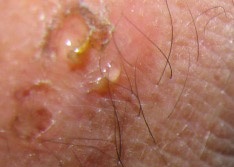Microscopic Polyangiitis
What is Microscopic Polyangiitis?
Microscopic Polyangiitis (MPA) is inflammation of the small and sometimes medium sized blood vessels. In the past MPA was thought to be a type of PAN and patients would have been told they had PAN. It is now recognised that they are separate diseases.
In microscopic polyangiitis it is common for the smallest blood vessels (capillaries) of the lungs and kidneys to be damaged leading to reduced kidney function or kidney failure and breathlessness.
Who are affected?
MPA is commonest in middle aged people and affects both men and women.
What is the aetiology (cause)
The cause of MPA is not yet known
The ANCA antibodies found in most patients with MPA play a role in causing the inflammation of the blood vessels by activating some types of white blood cell. The ANCA antibodies attach to the neutrophils in the blood causing activation. This makes the neutrophil attach to the blood vessel wall and cause damage by release of the chemicals that it usually uses to fight infection. It is not understood why patients develop ANCA antibodies.
What are the symptoms?

Common symptoms in MPA are tiredness, loss of appetite and joint and muscle aches. The other symptoms of MPA will depend on the organs involved and will vary markedly between different patients.
Occasionally MPA just affects the kidneys (sometimes called Renal Limited Vasculitis) so that an individual may only begin to feel unwell when the kidney function has deteriorated.
Some symptoms encountered, specific to various systems are:
- Lungs – breathlessness, wheeze, dry cough or coughing up blood
- Skin – rashes, ulcers, and necrosis (death of tissue)
- Eyes – red (blood shot) eyes, painful, dry or gritty eyes, visual loss or other changes in vision
- Nerves – loss of sensation, weakness, unusual painful symptoms in the hands and feet (hotness, pins and needles or “electric shocks”) and rarely paralysis or stroke
- Bowels – Diarrhoea, bleeding and abdominal pain.
Diagnosis
As with other type of vasculitis the diagnosis depends on the doctor recognising the pattern of symptoms and clinical signs. The ANCA blood test and a biopsy from the kidney or other affected organ are very helpful tests for MPA.
Treatment
Prednisolone (steroid) and cyclophosphamide are often used to get the disease under control in moderate or severe cases. In mild cases where the kidneys are normal milder treatment with prednisolone and methotrexate may be given. If the disease is very severe large doses of methylprednisolone or plasmapheresis (plasma exchange) may also be given. When the disease becomes quiet less toxic drugs are used to keep control which include: azathioprine, methotrexate and mycophenolate mofetil usually in combination with low dose prednisolone.
Rituximab has recently been shown to be effective in some cases of MPA instead of cyclophosphamide although it is not suitable for all patients.
Drugs and Side effects
For information on the main drugs prescribed for Microscopic Polyangiitis see:
For information on other drugs used in the treatment of vasculitis see Glossary of drugs and side effects.
Treatment – Plasma exchange or plasmapheresis
This treatment is sometimes used in patients with severe vasculitis where antibodies in the blood are thought to be important in causing the disease. The treatment involves removing antibodies from the blood using a machine and returning the “cleaned” blood back to the patient. The treatment may necessitate giving blood products to the patient including plasma, albumin or immunoglobulin. It may also involve giving drugs to thin the blood and prevent it clotting in the machine.
For information on plasma exchange:
Prognosis
The overall prognosis in MPA depends on the severity of the disease and the amount of damage that has been done to organs,especially the kidneys, when the disease was active.
Relapses can occur in MPA though less commonly than in some other types of vasculitis and usually require a temporary increase in treatment. It is not clear how long patients with MPA should remain on treatment for and this should be discussed with the doctors looking after the patient on an individual basis.
Key Points
- MPA is a rare form of vasculitis
- It often causes severe kidney and lung damage
- Treatment often requires high dose steroids and cyclophosphamide.
Related Vasculitis Articles
- Fertility and Vasculitis – Dr David Jayne
- Vasculitis and the Ears – Dr Marcos Martinez del Pero
- Vasculitis and the Eyes – Dr Catherine Guly
- Vasculitis in Children – Dr Paul Brogan
Further reading
- Recommendations on the use of Rituximab in ANCA-associated Vasculitis – Rheumatology 2012
- Microscopic Polyangiitis – Sharon A. Chung, Philip Seo
- Small Vessel Vasculitis – Paul Brogan, Despina Eletheriou, Michael Dillon
- Small vessel and medium vessel vasculitis – Philip Seo, John H Stone
- Management of ANCA-associated vasculitis: Current trends and future prospects – Sally Hamour, Alan D Salama, Charles D Pusey
- Guidelines for the management of adults with ANCA associated vasculitis – (Rheumatology 2007;46:1-11)
- Vasculitis Paediatric Guidelines 2012 – Dr Helen Foster & Dr Paul Brogan, Oxford University Press
Useful links
Our Useful Vasculitis Links page contains contact details for organisations offering help and support for patients with Microscopic Polyangiitis and other vasculitis diseases.
Acknowledgements
Vasculitis UK for providing the information.
